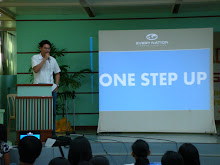A lot of people reacted strongly to what I wrote about the square watermelon. Majority of them liked the idea of innovation, but questioned how can it really be achieved, and if the inherent risks of failure is worth the effort. In today’s uncertain economic climate, some asked, is it really the right time to be innovating and how does one start?
Everybody loves successful innovations but not many want to be the one starting them. So what can we do? Rosabeth Kanter, a professor at the Harvard business school, wrote something revealing on starting innovation. She wrote a article on the "15 minute competitive advantage" which she said can be used to break innovation down to a manageable level, she wrote that change should happen , “in short fast bursts rather than waiting for the breakthrough that transforms everything. If every proverbial 15 minutes, you learn something and incorporate it into the next speedy step, you'll continue to be ahead. And a few time periods later, transformation will be underway.”
Professor Kantor is a firm believer that instead of changing the whole system, it should be changed just enough at a time but also continuously adapting and innovating. This will allow the company to listen and adapt to the market needs rather than force the latter to accept a whole new line of thought.
She emphasized, “Stay a little ahead of the competition while close enough to what customers can understand and incorporate, and the innovation idea is easier to sell” It actually makes so much sense.
Many instances will show us that even though the innovation made all the sense in the world, if we introduce it too rapidly or radically, it will cause the market to instinctively reject it. But by introducing it in short systematic bursts, it will allow the market to absorb it unconsciously.
The other point the Professor made is that the innovation should have certain characteristics in order to make it easier to accept and support, it should be:
1.
Trial-able: The idea or product can be demonstrated on a pilot basis. Customers can see it in action first and incorporate it on a small scale before committing to replace everything.
2. Divisible: It can be adopted in segments or phases. Users can ease into it, a step at a time. They can even use it in parallel with current solutions.
3. Reversible: If it doesn't work, it's possible to return to pre-innovation status. Eventually you want life to be unimaginable without it, but at least in theory, it's possible to go back to zero.
4. Tangible: It offers concrete results that can be seen to make a difference in something that users need and value.
5. Fits prior investments: The idea builds on "sunk costs" or actions already taken, so it looks like not much change is involved.
6. Familiar: It feels like things that people already understand, so it is not jarring to use. It is consistent with other experiences, especially successful ones.
7. Congruent with future direction: It is in line with where things are heading anyway. It doesn't require people to rethink their priorities or pathways, even though of course it changes things.
8. Positive publicity value: It will make everyone look good.
Do you agree? Her points do allow innovation to be thought of in a rational and realistic manner. So what are we waiting for? Let’s start looking for our own square watermelons, and take the first few steps into the innovation decade.
Let’s follow the examples of these ordinary individuals as they strive to make a difference. Each week, lets all get together and share knowledge, stories, experiences, information, all for the sole purpose of getting One Step Up.
For comments, suggestions or stories that you want to share, email me at stirspecialist@gmail.com , or visit www.stirspecialist.com






Comments (0)
Post a Comment